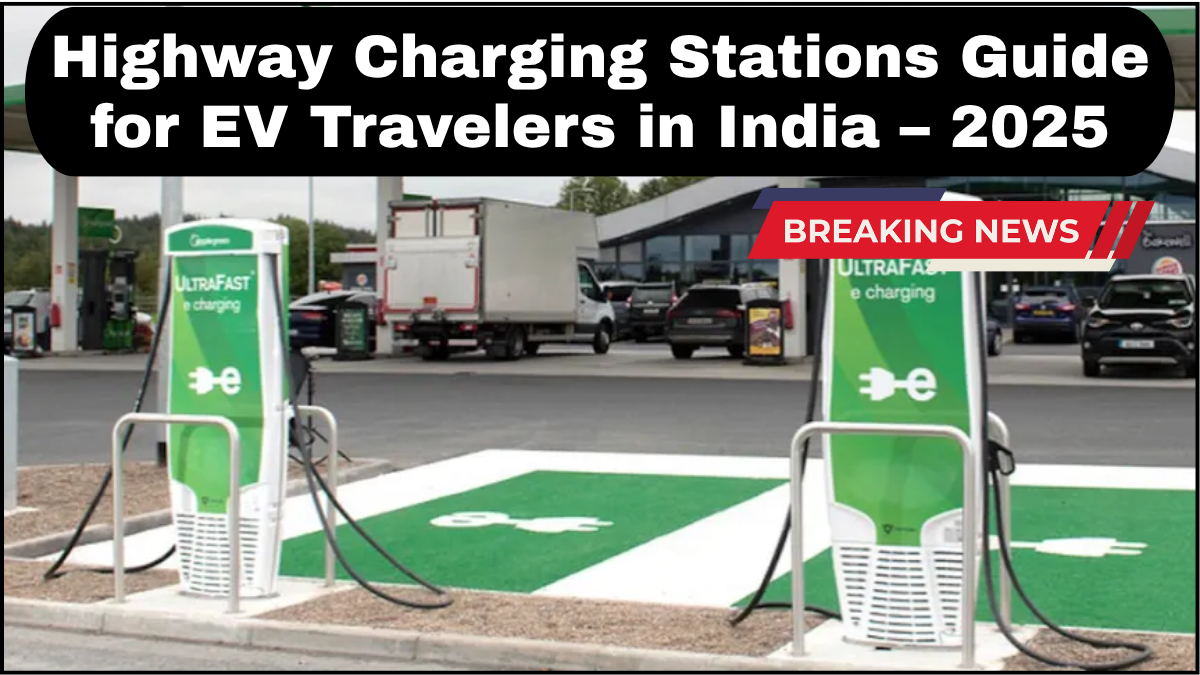As India accelerates its electric vehicle (EV) adoption, one critical component shaping the future of e-mobility is highway charging infrastructure. For EV travelers hitting the road in 2025, a well-informed plan around EV charging stops on highways is essential—not just for convenience but also for peace of mind. This guide serves as your comprehensive roadmap to navigating India’s expanding EV highway charging network, complete with tips, real-world insights, and helpful add-ons for tourists.

Why Highway Charging Stations Matter in 2025
India’s highways are more than just routes between cities—they’re lifelines for long-distance commerce, tourism, and intercity travel. With a surge in EV ownership, the demand for fast, accessible, and reliable charging points along national and state highways has skyrocketed.
As of 2025, the Ministry of Heavy Industries and private players have collectively established over 7,000 fast-charging stations along key national corridors such as the Golden Quadrilateral, North-South, and East-West expressways. This widespread availability has helped reduce range anxiety among EV drivers.
Types of Highway Charging Stations
Understanding what kind of charging station to expect can make all the difference on a road trip.
1. DC Fast Charging Stations
-
Found on major national highways
-
Charges up to 80% in 30-45 minutes
-
Supports CHAdeMO, CCS, and Bharat DC standards
-
Ideal for high-range EVs and urgent top-ups
2. AC Slow Charging Stations
-
Suitable for overnight stays or long breaks
-
Common at highway-side motels, dhabas, and small towns
-
Useful for budget-conscious travelers or older EV models
3. Battery Swapping Stations (Emerging Trend)
-
Pilot programs in Tamil Nadu and Maharashtra
-
Quick exchange of depleted battery with a fully charged one
-
Mostly used by fleet operators, but gaining ground among private drivers
Mapping Your EV Charging Stops on Highways
Route planning tools such as Ather Grid, Tata Power EZ Charge, Statiq, and PlugNgo offer real-time data on station availability, pricing, and connector type. Google Maps has also integrated EV charging points, which helps drivers choose pit stops efficiently.
A typical Delhi to Jaipur EV drive in 2025, for instance, has at least five well-distributed charging stops on highways, with most fast chargers located within 100-150 km intervals. This makes it easy to plan a charging break that aligns with mealtimes or sightseeing opportunities.
EV-Friendly Highways in India
Certain highways are becoming increasingly EV-focused, thanks to government and private sector collaboration. Key examples include:
-
Delhi-Mumbai Expressway – Over 100 charging points by 2025
-
Bangalore-Chennai Highway – Powered by high-capacity solar chargers
-
Ahmedabad-Surat-Vadodara – Dense charging network with AC and DC options
-
Kolkata-Digha Route – Promoted under eco-tourism initiatives
These corridors also double as tourist guides, offering curated experiences like eco-parks, heritage stops, and food trails—turning functional pit stops into memorable detours.
Charging Station Amenities
Modern EV charging stops on highways aren’t just plug-in zones—they’re mini-hubs of comfort. Most tier-1 and tier-2 stations offer:
-
Washrooms and rest areas
-
Cafés and restaurants
-
EV servicing kiosks
-
Surveillance and lighting for night-time charging
-
Payment via UPI, credit card, or mobile apps
Look out for government-accredited Green Stations for eco-friendly amenities and solar-powered chargers.
Travel Tips for EV Drivers in India – 2025
-
Pre-book slots during peak travel seasons like long weekends and festivals.
-
Carry multiple connector adapters if you’re driving a non-Indian brand EV.
-
Use mobile apps with live station status to avoid wait times.
-
Plan overnight stays near AC charging stations to combine rest with slow charging.
-
Monitor power outages in rural stations via community platforms or station alerts.
What to Expect in the Near Future
By the end of 2025, India aims to have a charging station every 60–70 km on major highways. Ultra-fast chargers (350 kW+) are also in trial phases across several states. Combined with solar microgrids and battery storage units, India is on track to support a robust, green travel ecosystem for EVs.
FAQs – EV Highway Charging in India
Q1: How often should I charge during a long highway trip?
A: Ideally, plan for a charging stop every 150–200 km, or around 30–40% battery remaining. Fast chargers help reduce downtime.
Q2: Are EV charging stops on highways open 24/7?
A: Most DC fast-charging stations along major highways operate 24/7, but always check via the provider’s app for status and availability.
Q3: Can I find charging stations in remote areas or smaller towns?
A: While access is limited in remote regions, most state highways and popular tourist routes now include at least a few charging options.
Q4: Is it safe to leave my car charging at night on a highway?
A: Yes, most modern charging stations are well-lit and have CCTV monitoring. Still, use your judgment and prefer secure, populated areas.
Q5: Are there charging stops at tourist attractions?
A: Yes, several heritage sites and eco-tourism spots, especially in Kerala, Himachal Pradesh, and Rajasthan, have begun offering charging options as part of green travel initiatives.
click here to learn more